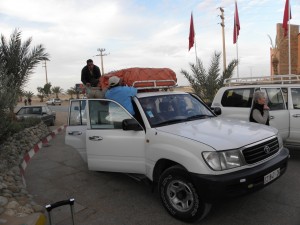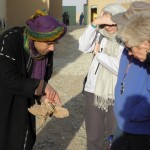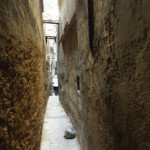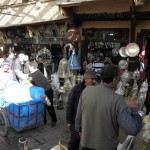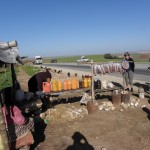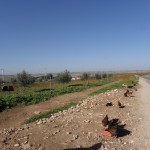Up early in Erfoud, we loaded our gear onto our assigned four-wheel drive vehicles. We were split into groups of four fellow travelers assigned to the same shephard driver for the next few days. Erfoud is an enormous military town but the surrounding region specializes in unique marble and granite whose rare distinction is enormous embedded fossils. So the days stops included a fossil marble works, a school established about 2 years ago for nomadic children, a camel ride and then checking out and settling in to our camp site.
Fossil Finds at Edge of the Sahara
- Learning to See
- Fossils to Kitsch
- Turning Out the Tchotchke
- Fossils Galore
- Archeological Rigor
- Showroom Bargains
An early Mid-December morning and we were clambering over huge stacks of fossis embedded in marble learning about what these resourceful craftsmen could make to both sell to tourists and market abroad. What a pitchman!! Handsome, charming a notice his American levis peeking out from under his native costume.
Fez Up
The Medina of Fez is a warren of dark alleys and twisting turning passages densely congested with people, animals and carts bearing life’s essentials. Traffic flows in both directions. Relentless shouts of warning “Barek, barek!!” (Look out!) flatten all but the burdened against the walls as the porters exercise their right-of-way. Doorways to souks, to sacred Muslim buildings as well as to homes emerge every few steps along the murky passages. Small children move about confidently on their way to school or another destination without any apparent care about loosing their way. We, as visitors, would have probably been more comfortable with a knotted rope like preschoolers or at least dropping some crumbs. I scarcely look down for fear of loosing line of sight with our guide. Guide books promise that “going steadily with the flow” eventually leads to a gate.
- Gathering Outside the Gate
- The Press is Unrelenting
- Daily Traffic
- Re-dying Used Clothing Black for Resale
- Just a Peek of Sky
- One of the Thousands of “Time-warp” Alleys
- A Bit of Open Space in the Heart of the Medina
- “Barek, Barek!!”
- Recently Refurbished Mosque
- Prayers are Over
- More Portage
- Yet Another Beautiful Surprise Doorway
- The Iron Works Neighborhood
- Weavers Quarter
- Always Bustling
- Herb Seller for a Lifetime
- Fresh Fish Daily
- The Daily Bread
- Daily Shopping for Daily Needs
- 13th Century Buildings Seem to Prop Up One Another
- Souk Dabbaghine–Tanner’s Quarter
- Whatever You Desire–it can be found here.
- Wedding Celebration Props–to rent or purchase
- Elegant Moroccan Furniture and Style
Overland to Volubilis
An early departure put us on the road to Fez. Stops and discoveries along the journey began unfolding the daily life of the majority of Moroccans allowing us to appreciate the present as it is still dramatically shaped by their fascinating history.
We meandered along and over the local by-ways through rich rolling farmland, olive groves and vineyards. Most of this verdant land is dependent entirely upon rainfall and the waterways descending from the Rif and Middle Atlas. Land is divided into small family farms or groves, Villagers grow wheat, barley, citrus and cotton in a mild climate a lot like Southern California Migrant workers live on government lands and move around as the seasons change supplementing their income with what they can produce and sell along the roadside. It was the end of olive season and but we saw men and women working together to finalize the last harvesting.
Lunch in Meknes, heart of a vibrant wine growing area, a city divided into ancient and modern. The old part is on the west bank of the river Oued Boukfrane with the new town on the east. Pictured below is the Bab el-Mansour, the main gate leading into the medina proceeding through a ring of battlements. Described as far less touristy than Marrakesh or Fez, there are still abundant souks selling carpets and handicrafts but the local tradesmen and service people are there primarily for the locals.
Volubilis, the day’s highpoint, suddenly came in view as we swung around a valley and passed through the groves and family farms at the outskirts of Moulay Idriss, a vibrant small town. The Triumphal Arch signals the site and is visible from the approach. Ruins largely date from the 2nd and 3rd centuries AD but excavations reveal that the original settlement was by Carthaginian traders in the 3rd century BC.
